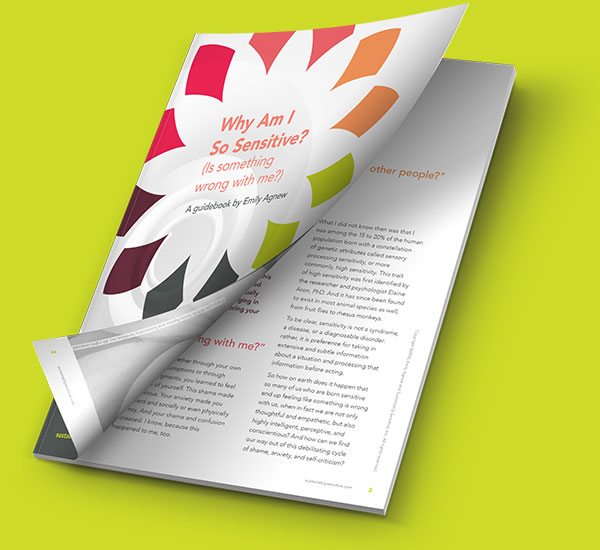If you find yourself saying, “I don’t like to label myself sensitive,” read on. The HSP label can be useful, IF you use it the right way.
A man named Alex once contacted me to ask about Focusing. When I responded, I included information about high sensitivity (HSP), sensing that the information might resonate with him.
Alex replied that he had in fact come across Elaine Aron’s book, The Highly Sensitive Person. He added,
Very interesting. I don’t like labeling myself but I see something in me that is very sensitive. I can see the connection with shame for feeling sensitive and how I and others push me.
Alex had captured a key point. Many HSPs, including me, are ambivalent about the label. As Alex perceptively noted, this ambivalence can reflect shame about ourselves. This shame can cause us to push ourselves too hard, and to tolerate being pushed by other people.
When “HSP” feels like a badge of shame
I wrote back to Alex to say I got it about not wanting to label himself. I added,
The literature about the highly sensitive trait is a helpful aggregate of information which can make sense of a lot of things, but in the end it all comes down to letting go of all stories and connecting to one’s spiritual source. It’s just easier to do that when one is caring for oneself well, and because HSPs need a different kind of self-care than the majority of people, this can be hard to do if we don’t get some kind of normative information or validation along the way.
To put this another way, the HSP label can be extremely helpful if the motivation for applying it is to learn more about how to care for yourself. On the other hand, the label feels like a badge of shame to you, then that is clearly a problem.
Unfortunately, many of us have learned to shame ourselves. Perhaps we grew up with people who directly told us we were “too sensitive.” Or we may have sensed we were somehow different from others around us, and we judged that difference as negative.
Either way, the issue of labeling oneself “sensitive” is painfully relevant for many of us. It’s worth taking time to explore it further.
Labels are a risky business
First of all, let’s be clear that any label, whether positive or negative‚ is a form of judgment. We use labels to lump people into groups. This can be convenient. However, we run the risk of overriding their individual humanity. The highly sensitive label certainly carries this risk: it is too often used in a pejorative way.
No one wants to be labeled “too sensitive.” Even without that judgment, though, there’s another reason you might reject the sensitive label: managing your sensitive trait can be a challenge. After all, you didn’t ask to be born this way. You may hope that if you avoid calling yourself sensitive, you can avoid being sensitive.
However, a rose by any other name is still a rose. If you try by sheer force of will not to be a rose, you create a dilemma for yourself. Roses need different care than, say, daisies. Alex was speaking to this problem when he remarked, “I can see the connection with shame for feeling sensitive and how I and others push me.”
There’s no way around this. If we are built sensitive, we will experience the different aspects of the trait in our bodies, whether we acknowledge them as legitimate or not. If we don’t acknowledge our sensitivity as legitimate, we will, like Alex, push ourselves to match the pace and intensity of the less-sensitive majority culture. And we will allow ourselves to be pushed by others.
Is there a helpful way to use the “sensitive” label?
Fortunately, yes. There is. Rather than throw the baby out with the bathwater, we can reclaim the “sensitive” label. We can dust off the judgments we (and others) have put on it. Then we can use the word “sensitive” as a convenient name for “a helpful aggregate of information”, as I described it to Alex.
We urgently need to make this attitude shift, because the body of information available to us about the HSP trait—including Elaine Aron’s books—is invaluable. By accepting the reality of the trait, you gain access to transformative information. You learn why you experience things the way you do.
With this information, you are now equipped to learn how to take the best possible care of yourself. You may be a college student, a parent, a busy professional, or the caregiver to an elderly relative. You may even be an elderly relative yourself. It doesn’t matter. This is a life-long project. Whatever stage of life you are in, understanding your trait makes all the difference in knowing how to keep yourself sane and well-regulated.
“But I still don’t like labeling myself!”
Fair enough. But I have good news. You can have your cake and eat it too. First, you embrace and absorb the invaluable information contained under the label of sensitivity. Then, rather than rejecting the label because it has at times been used to shame you, you can transcend it. To revisit my comment to Alex,
…in the end it all comes down to letting go of all stories and connecting to one’s spiritual source. It’s just easier to do that when one is caring for oneself well, and because HSPs need a different kind of self-care than the majority, this can be hard to do if they don’t get some kind of normative information or validation along the way.
To be more specific, sensitive people are hardwired for spiritual connection. However, our connection easily gets scrambled if we don’t know how to manage the deep thinking, the vulnerability to overarousal and anxiety, the emotional intensity and the sensory sensitivity that come with the trait.
This means that for HSPs, self-care and spiritual connection form an infinite loop. The better your self-care is, the easier it is to connect to your spiritual intuition. The clearer your spiritual intuition, the easier it is to sense how best to care for yourself, moment by moment.
Harnessing the power of “both/and”
No doubt, we have a paradox here. We want to transcend the whole idea of sensitivity. But in order to do that, we need to attend to our self-care…and that means familiarizing ourselves with the information defined by the HSP label.
How can you manage this paradox? I do best when I take advantage of the practical information defined by the sensitive trait, while simultaneously holding on to the truth that my essence as a person goes beyond any concept, label, or definition.
You can try this approach for yourself each time you encounter information about sensitivity. Take in the information. Then get quiet and sense if the insight or the suggested action resonates with your spiritual intuition. If it does resonate, take action. Afterwards, get quiet once again. Sense how you feel.
Do you feel more peaceful, joyful, and energetic, and more in integrity with yourself and others? This is clear feedback that you are on the right track. You have taken actions on the physical plane that serve you on the spiritual plane. The two are closely related: it’s hard to hear your spiritual intuition when you are exhausted, overwhelmed, anxious, hungry, or overstimulated.
As the sun sets over the water, it is reflected in the water. Yet it is not immersed in the water. In the same way, you can take in information about sensitivity without immersing your identity in it. This is not a “one-and-done” action, but a daily unfolding.
You learn more about your sensitive body and nervous system. Then you care for yourself. Each time you do this, you gain more peace and presence. You transcend your sense of self a bit more. Then, like the sun rising and setting, you repeat the process.
Photo: 2023 Kaitlyn Wyenberg. Thank you Kaitlyn!
Note: This post is an expanded and edited version of the one that originally appeared on February 19, 2019.




















I was looking for a blog to share what I have to share and this one is the closest I could find. I just watched a youtube video by an LFMT (hopefully I have the letters in the right order). She has a video about being HSP. She states she scored 14 (which is just above the 12 mark ) on Dr. Aron’s HSP self test . She goes on to share how HSP people need to share this trait reality with their Mental Health Care Providers……I just went through hell (really) trying to explain to a psychiatrist, for a good 8 months, as to how senstive I am to the side effects of medication. ( I answered yes to all of the HSP self test questions) I also tried to explain my HSP trait to a psychologist. Being HSP IS NOT A MENTAL HEALTH CONCERN, it is a physically inherited trait. I know you, Emily, know this, I’m more or less venting here. I couldn’t find a ‘contact’ place on this woman’s website to share my concerns about what she was saying on her video. This was the first HSP video I have come across that really did no service to the HSP trait. I hope someone points this out to her. My attempts at explaining my HSP trait to a psychiatrist was overlooked and met with a prescription for Zyprexa! ( a very potent antipsychotic drug). He told me , because I had been crying so much, that ‘it would take the edge off’. WOW……..I’m doing much better now….only on my antidepressant…but WOW. Thanks for having this space for HSPs to comment and share. So….to tie this in……HSPs need to find health care professionals who understand the HSP trait and are knowledgeable with it…otherwise we are treated as extremely sensitive people…neurotic, hypochondriacs, unintelligent..and the list goes on.
I recently shared with my nephew, who is only 20, about this inherited trait…calling it a Highly Absorbing Nervous System Trait….and Magnifying Glass Nervous System Trait….gets away from the ‘sensitive label’.
Thank you Emily for yet another insightful and incredibly helpful piece. You just get it, and your ability to explain yet lighten the load is gold. I am a huge fan of your work. Thank you again and keep the blogs coming!